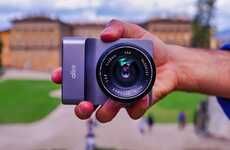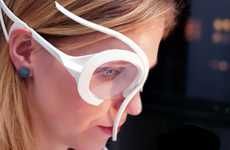
The Iris Camera Sees the World How You Really See It
Shiori Mine — June 26, 2012 — Tech
While DSLR technology is becoming more accurate by the day, the Iris Camera does what no current model can: capture what you truly see through an eye-operated lens.
Designed by Royal College of Art graduate Mimi Zou, the Iris Camera is maneuvered using the movement of the human eye. When the operator blinks, the device snaps the image ahead and as they squint, the lens adjusts focus. DSLR cameras are designed to operate like the human eye, thus this design takes the process even closer to the real deal. Biometric technology allows the camera to remember and identify the distinctive patterns individual to each human eye.
The camera is also equipped with Wi-Fi capabilities and tagging implements, which allow users to quickly connect with their friends digitally. The Iris Camera is yet another great example of how technology and humans are growing closer together.
Designed by Royal College of Art graduate Mimi Zou, the Iris Camera is maneuvered using the movement of the human eye. When the operator blinks, the device snaps the image ahead and as they squint, the lens adjusts focus. DSLR cameras are designed to operate like the human eye, thus this design takes the process even closer to the real deal. Biometric technology allows the camera to remember and identify the distinctive patterns individual to each human eye.
The camera is also equipped with Wi-Fi capabilities and tagging implements, which allow users to quickly connect with their friends digitally. The Iris Camera is yet another great example of how technology and humans are growing closer together.
Trend Themes
1. Eye-operated Lenses - Disruptive innovation opportunity: Explore the potential for eye-operated lenses as a new way to capture and document what individuals truly see.
2. Biometric Technology - Disruptive innovation opportunity: Investigate the applications of biometric technology in photography and imaging to enhance user experience and personalize camera settings.
3. Connectivity and Tagging Implements - Disruptive innovation opportunity: Consider the integration of Wi-Fi capabilities and tagging implements in cameras to enable seamless digital sharing and social connections.
Industry Implications
1. Photography - Disruptive innovation opportunity: Transform the photography industry by introducing eye-operated lenses and leveraging biometric technology to enhance user experience.
2. Consumer Electronics - Disruptive innovation opportunity: Revolutionize the consumer electronics industry by incorporating eye-operated lenses and biometric technology into camera devices.
3. Social Networking - Disruptive innovation opportunity: Explore the potential for eye-operated lenses and connectivity features to enhance social networking platforms and digital sharing experiences.
4.3
Score
Popularity
Activity
Freshness















